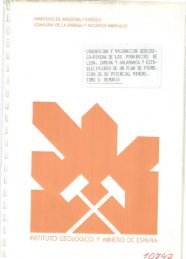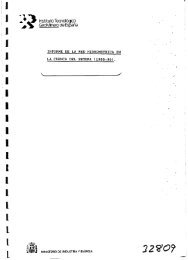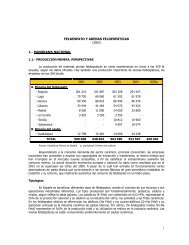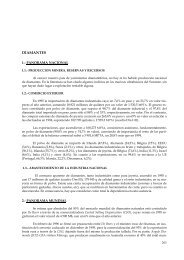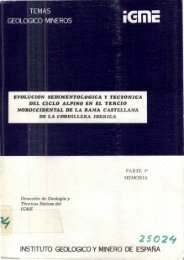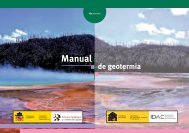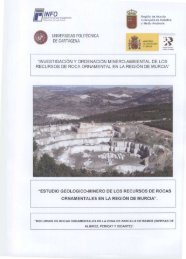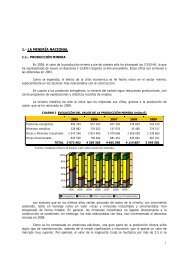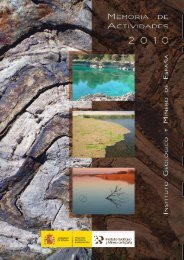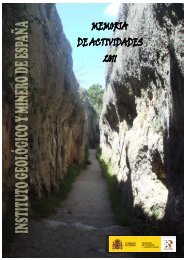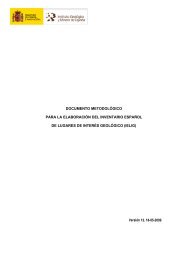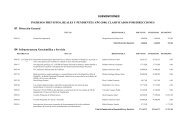6. Rotational kinematics of the Boltaña anticline - Instituto Geológico ...
6. Rotational kinematics of the Boltaña anticline - Instituto Geológico ...
6. Rotational kinematics of the Boltaña anticline - Instituto Geológico ...
Create successful ePaper yourself
Turn your PDF publications into a flip-book with our unique Google optimized e-Paper software.
<strong>Boltaña</strong> <strong>kinematics</strong> Mochales, 2011<br />
1.1. Definition <strong>of</strong> this research<br />
5<br />
1. Objectives<br />
This work deals with timing, <strong>kinematics</strong> and origin <strong>of</strong> oblique structure present in <strong>the</strong><br />
Sou<strong>the</strong>rn Pyrenees using as a main tool paleomagnetism in its broadest sense; both as a dating tool and<br />
as a way to obtain vertical-axis rotations. Moreover, analyses <strong>of</strong> <strong>the</strong> Anisotropy <strong>of</strong> <strong>the</strong> Magnetic<br />
Susceptibility (AMS) have been performed to decipher additional details <strong>of</strong> <strong>the</strong> <strong>kinematics</strong> <strong>of</strong><br />
structures. These approaches have been especially focused on <strong>the</strong> <strong>Boltaña</strong> <strong>anticline</strong> and nearby areas.<br />
The interest <strong>of</strong> this structure lies in its present orientation (N-S), oblique* with regard to <strong>the</strong><br />
dominating Pyrenean trend (ESE-WNW). The location <strong>of</strong> <strong>the</strong> <strong>Boltaña</strong> <strong>anticline</strong>, at <strong>the</strong> boundary<br />
between <strong>the</strong> siliciclastic Tremp-Graus Basin and <strong>the</strong> turbiditic and molasse Jaca basin (<strong>the</strong> so-called<br />
Aínsa basin), as well as its structural position at <strong>the</strong> western limit <strong>of</strong> <strong>the</strong> South Pyrenean Central Unit,<br />
add interest to <strong>the</strong> interpretation <strong>of</strong> its complex evolution. The implications <strong>of</strong> <strong>the</strong> <strong>kinematics</strong> <strong>of</strong> <strong>the</strong><br />
<strong>Boltaña</strong> <strong>anticline</strong> in <strong>the</strong> evolution <strong>of</strong> <strong>the</strong> turbiditic Aínsa Basin (that is commonly used as a model <strong>of</strong><br />
turbiditic deposition in slope areas) has aroused <strong>the</strong> traditional interest <strong>of</strong> a broad number <strong>of</strong> scientists<br />
and oil companies. The vast amount <strong>of</strong> studies here developed allows us for relying on a well-known<br />
area whose temporal framework is not yet accurately unravelled.<br />
The arrangement <strong>of</strong> this report has been done according to <strong>the</strong> disciplines used to establish <strong>the</strong><br />
<strong>kinematics</strong> <strong>of</strong> <strong>the</strong> <strong>Boltaña</strong> <strong>anticline</strong> and its temporal framework. Chapters two and three focus on <strong>the</strong><br />
geological setting based on previous investigations. The second chapter explains <strong>the</strong> geological frame<br />
from <strong>the</strong> plate scale to <strong>the</strong> scale <strong>of</strong> thrust sheets. There, <strong>the</strong> crustal structure and <strong>the</strong> partitioning <strong>of</strong> <strong>the</strong><br />
Pyrenees are detailed. The third chapter is related to detailed stratigraphic and structural features <strong>of</strong> <strong>the</strong><br />
Aínsa Basin and <strong>the</strong> <strong>Boltaña</strong> <strong>anticline</strong>. Previous paleomagnetic studies involved in <strong>the</strong> study area are<br />
overviewed in this chapter as well. The fourth chapter deals with <strong>the</strong> metholodogy applied in this<br />
study. Here <strong>the</strong> paleomagnetic and magnetic fabric principles are centred on <strong>the</strong> relevant aspects for<br />
this work.<br />
Once focused <strong>the</strong> study area, <strong>the</strong> main body <strong>of</strong> PhD is developed in <strong>the</strong> following chapters.<br />
The different kinds <strong>of</strong> new data produced in this work are described separately. The chapter number<br />
five presents <strong>the</strong> magnetostratographic study carried out in <strong>the</strong> Aínsa Basin. It is based in <strong>the</strong><br />
continuous sampling performed throughout <strong>the</strong> Eocene rocks. It deals mainly with dating questions<br />
and <strong>the</strong>refore paleomagnetism, biostratigraphy and mapping achieved special relevance in this chapter.<br />
The sixth chapter analyzes <strong>the</strong> problem <strong>of</strong> <strong>the</strong> oblique structures <strong>of</strong> <strong>the</strong> South-Pyrenean Zone,<br />
namely <strong>the</strong> western boundary <strong>of</strong> <strong>the</strong> South Pyrenean Central Unit (SPCU) where <strong>the</strong> <strong>Boltaña</strong> <strong>anticline</strong><br />
is located, from several points <strong>of</strong> view. From <strong>the</strong> <strong>kinematics</strong> point <strong>of</strong> view, <strong>the</strong> analysis <strong>of</strong> <strong>the</strong><br />
pretectonic, syntectonic and postectonic sequences by means <strong>of</strong> <strong>the</strong> study <strong>of</strong> Vertical Axis Rotations<br />
(VAR) is performed.<br />
*Oblique structure is defined as a structure with whose oblique to <strong>the</strong> main trend <strong>of</strong> a range.



